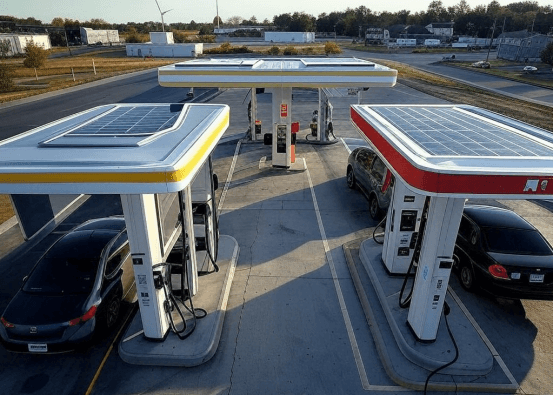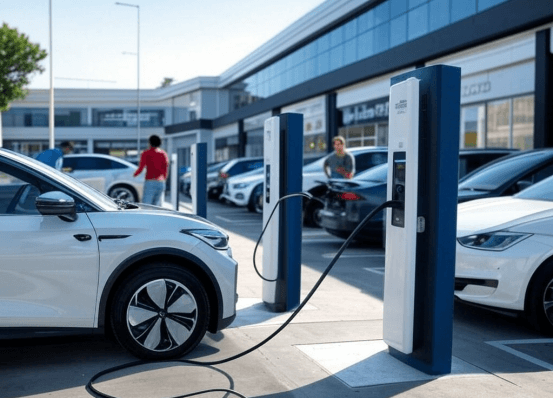What's Behind the Race to Build Infrastructure Hidden Forces
It was a frigid February night in 2025, and a parade of electric vehicles snaked up and down in front of a Tesla Supercharger station, the drivers enduring the elements for their turn. One passerby took a photograph of the scene and then posted it to Reddit, where the shot went viral, amassing more than 100,000 upvotes. "This is not a charging station — It's the new gold rush," the user @EVDriver2025 joked. That close-up — a father and son in their backyard, the family's electric car parked a short distance away — is a portrait of the charging station standoff redefining America's electric vehicle landscape.
The Charging Crunch: An Electric "Oil Crisis”
As though even the thought of such a fissure adds to the fractures that are currently cleaving society, just imagine standing in line for gas during the fuel crisis of the ‘70s — except it's 2025, and the gas is electric. As of January, the ratio of public chargers per EV in the U.S. was 1:18, Green Car Reports says, well short of the desired 1:10. California's Highway 101 — average wait, 47 minutes. "We're not a cash cow we're lining up for optimism," a driver of a Rivian car wrote on Twitter.
So what we do in the other direction creates a skewed "charging economy." Fast-charging rates for the equivalent period in Q1 2025 were up 35% YoY over the same quarter in 2023, according to ChargePoint data, with some peak-hour charges at some locations exceeding gasoline fuel prices. Tesla poked the bear last March by upping fees 50% for non-Tesla EVs who plug in to its stations, lighting up a firestorm on socialeedia. "This is monopoly in the electric age,” CNBC's Jim Cramer said on his show.

Lurching forward: States Vs. Big money
And now the Biden administration's $7.5 billion effort to fund charging infrastructure is paying dividends. By early 2025, you could find more than 124,000 new chargers installed across the United States, about 40 percent of which were on highways, the Department of Energy said. But here's the rub: Electrify America took some heat in February for situating 80 percent of its new chargers within five miles of existing stations, leaving behind underserved gaps. "They're fiddling with the numbers," Senator Elizabeth Warren fumed at a hearing.
And now the private operators are coming to the plate. In March, Shell also spent $2 billion to acquire ChargePoint as it shifts focus from gas stations to charging hubs. Walmart was then working with Tesla to deploy Superchargers at 2,800 locations. "Retail is following suit in rewriting the charging playbook," noted Fortune.
Tech Leap: Look Beyond The Load Speed
In January 2025, the Tesla brand launched its V4 Supercharger at CES, claiming 200 miles of range after five minutes of being plugged in, only to have Consumer Reports not be convinced — those figures are only achievable under optimal conditions. "It's like an MPG lab certified," said editor Jake Fisher.
Wireless charging had stolen some of the thunder, though. $2 million per mile is still a dream and Electreon tested a one mile stretch of this in Detroit in February. "The future's here — just not today," Jim Farley, the chief executive of Ford, told me after a recent drive.
Backyard brawls: The NIMBY counterrevolution
In one suburb, a proposal for a new charging site devolved into a shouting match. "We don't want these ugly metal poles," resident Mary Smith screamed at city hall. That Not In My Backyard mindset is going nat ional — 47 wiring projects "un wound across the country in Q1 2025 as a result of com mun ity opposition. "We have to be better communicators to communities," ChargePoint CEO Pasquale Romano said in an interview with Automotive News.
So a PoP or Bust straddle business model
Charging firms are losing money. In Blink Charging Q1 2025 earnings it earns only $8.70 a day per charger, nowhere near the break-even $15. "We are running a hype factory and have zero profit," said the chief executive, Brendan Jones.
And here's where the pivot comes in: In March, Tesla came out with a $19.90-a-month "charging membership" that would open up access to better rates, and Walmart began laying down "shop-and-charge" spots — spend $100 and get an hour free. In-store tie-ins, however, might crack the code, John Waters of McKinsey said.
Standards Standoff — Plug Wars
Sure, Tesla opened its NACS standard to all carmakers (and it became available in February 2025), but it was only Ford and GM that bit. "It's monopoly by another name," The Wall Street Journal quoted Scott Keogh, the chief executive of VW America, as fuming. And this plug tug-of-war is destroying efficiency — CCS chargers earned a mere 23% average utilization in Q1, while Tesla's Superchargers earned an average of 78%, J.D. Power says. "We need one standard, end of story," said John Bozzella, the president and chief executive of the Alliance for Automotive Innovation.

What's next: Are you prepared for charging as a service?
Then a head-fake bait-and-switch in March by Amazon: a "Charging as a Service" — pay a flat monthly fee for unlimited juice at partner stations. "It's the Netflix of charging," Forbes said of the service. Outlandishly, Tesla's Elon Musk teased on X something even crazier: "mobile charging robots” that would go prowling for distressed EVs. "Charging stations may not even exist in this potential world," speculated Adam Jonas of Morgan Stanley.
This is not just a tech problem anymore — it's a social, economic, political problem. As the New York Times' Thomas Friedman noted, "Charging stations are redrawing America's social map." "They just drew the line in the sand, and the revolution will only just begin — in every neighborhood, every freeway and every parking lot, one plug at a time.”
Why It Matters to You
That adds latency and recharges for drivers, unless you get membership bonuses or live in a commercial cluster. For the vicarious, it's a front-row seat at a War of Innovation, Profits and Politics that's dragging us into an electric future. Well, you know — what ain't over; there's some twists and turns coming.